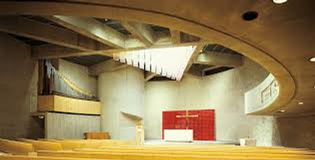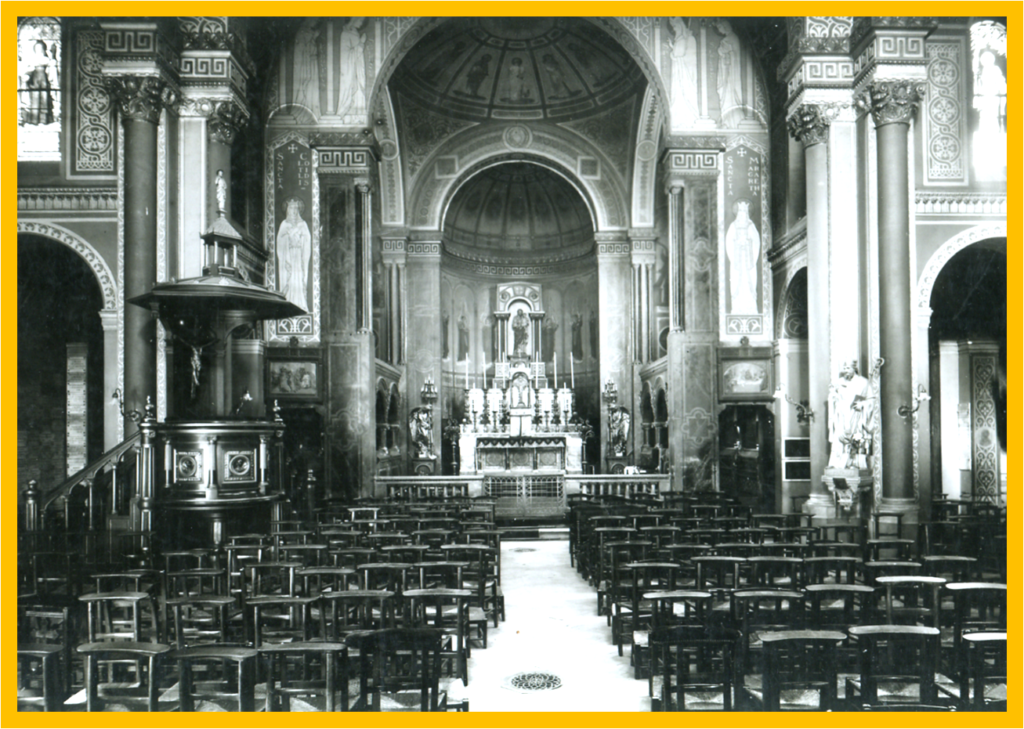The current building that houses St. Joseph’s Church was inaugurated in May of 1987.

Though it is indeed a relatively new structure, it stands upon the same ground and has the same historical roots as its predecessor, the original St. Joseph’s Church, the beginnings of which go back to 1863.

It was in that year that Father Ignatius Paoli, C.P., Provincial of the Anglo-Irish Province of the Congregation of the Passion, and later Archbishop of Bucharest, stopped in Paris en route to a General Chapter of the Congregation in Rome. During his stay he met Father J.S. Rogerson, an English priest known as “the English chaplain”, who told him of his efforts to find priests to minister to the growing English-speaking Roman Catholic population of Paris.
In spite of the wholehearted support of Monsignor Manning (afterward Cardinal and Archbishop of Westminster), Father Rogerson’s appeals to the English and French hierarchies had produced promises, but no priests.
Taking up this cause, Father Ignatius put the situation to the General Chapter when he reached Rome. He had gone to the right place for action. Within two months, three Passionists were sent to establish an English-speaking Roman Catholic church in Paris. Under the guidance of Father Bernard O’Laughlin, C.P., they took up residence at 39 rue de Berri, and began their ministry in a chapel of Saint-Nicolas de Beaujon on the rue du Faubourg Saint -Honoré.
There they remained for six years while awaiting the building of a church of their own. That church, St. Joseph’s, located on the Avenue de la Reine Hortense (today’s Avenue Hoche), was consecrated in June of 1869 on the Feast of Saints Peter and Paul.
From its founding to the present, the history of St. Joseph’s Church is rich and varied, both in terms of the community it has gathered and served, and in terms of the social and political events that have come with being a church at the heart of a major European capital.
Only a year after its consecration, Saint Joseph’s future was at risk, for in the summer of 1870 the Franco-Prussian War plunged France into the chaos that would culminate in the siege of Paris and eventually lead in 1871 to the carnage of civil war and the Paris Commune, a movement so fervently anti-clerical that the Archbishop of Paris was murdered in its wake. Grim as conditions were, the Passionists persevered and St. Joseph’s survived to become, by the turn of the century, a well-established church playing a vital role in the spiritual life of the city’s English-speaking Christian community.
During these years, the pastoral work of St. Joseph’s reached out in many directions. The archives document, for instance, the good works undertaken by the church’s chapter of the Saint Vincent de Paul Society. They record, to take a different example, that on the day before his death Oscar Wilde was baptised by one of St. Joseph’s priests and was given the last rites on the following day. In another context, they show St. Joseph’s as welcoming “the fashionable, aristocratic, diplomatic, literary and financial world of Paris…”
Twentieth Century History
In October of 1900, however, the continued existence of St. Joseph’s was suddenly in jeopardy when the government threatened confiscation of church and rectory subject to a tax of 20,000 francs — a sum the priests themselves could not possibly pay. Although a friend and benefactor of the church saved St. Joseph’s by paying the tax, this reprieve was short-lived; for in 1905, under the Law of Associations, St. Joseph’s and its rectory were expelled. Fortunately, the property was repurchased by the Passionists, who were permitted to return to their mission with the proviso that they not wear religious garb or any other marks of affiliation with a religious order.
Thus, when the First World War erupted, the priests of St. Joseph’s were at hand to minister to the English-speaking soldiers of the Allied Forces. Alas, it was not, as thought at the time, the war to end all wars, but in its aftermath, life in Europe undeniably changed, becoming more fluid, unsettled and complex. Representative of this was the influx of Americans coming to experience Paris or stay on as expatriates; and the new wave of young Irish women arriving to be employed as nannies or to teach English. Thus, the post-war era saw St. Joseph’s become the spiritual home for an increasingly diverse population of anglophone Catholics.
The Second World War and the Occupation of France and her capital obviously had deep repercussions on life at St. Joseph’s. That the church continued to function at all is undoubtedly due to the fact that the Passionists replaced St. Joseph’s English priests with Irish Passionists, who were protected to some extent by their country’s neutrality. The community –priests and parishioners –held together in no small measure due to the faithful support of a number of French parishioners. Thus when peace came St. Joseph’s was ready to take on the challenge of reconstruction.
Challenges have not been wanting in the post-war period. The early years were hard ones for the residents of Paris, with few material comforts and strict rationing. St. Joseph’s was all the more important as a place of spiritual nourishment, both in the sacraments, and in the cup of tea and shared loaf of bread that the priests would bring out for visitors.
With the steady rise of affluence, in the 1950’s and 60’s, and the explosive growth of the English-speaking Catholics, it was not easy bringing together national groups who might have seen themselves as constituting distinct communities. Indeed, the Vatican II reforms, with their emphasis on the Parish as a living community, posed a particular challenge for St. Joseph’s in view of the cultural diversity and geographic separation of its members.
The spread of English-speakers into the suburbs, and with it a partial assimilation of longer-term residents into local parishes, also complicated the task of defining the community: successive censuses during the 1960’s and 1970’s reveal dramatic fluctuations in the size and composition of the parish over even very short periods.
That St. Joseph’s not only met these challenges, but turned them into opportunities for making a common faith and a common language the touchstone of a richer sharing among people with very different cultures, means, and aspirations, is the most precious legacy that the Passionist priests of the past 25 years have left to St. Joseph’s parish of today.
